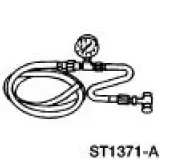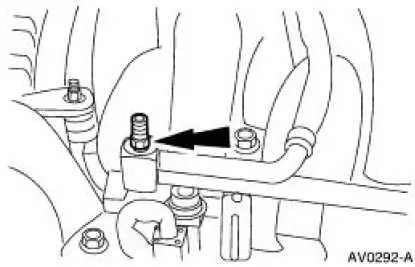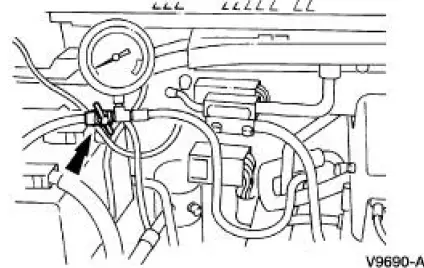Ford Mustang (1999-2004) Service Manual: Pressure Relief
Special Tool(s)
 |
Fuel Pressure Gauge 310-012 (T80L-9974-B) |
WARNING: Do not smoke or carry lighted tobacco or open flame of any type when working on or near any fuel-related components. Highly flammable mixtures are always present and may be ignited, resulting in possible personal injury.
WARNING: Fuel in the fuel system remains under high pressure even when the engine is not running. Before servicing or disconnecting any of the fuel lines or fuel system components, the fuel system pressure must be relieved to prevent accidental spraying of fuel, causing personal injury or a fire hazard.
1. Remove the Schrader valve cap and install the Fuel Pressure Gauge.

2. CAUTION: Open the manual valve slowly on the Fuel Pressure Gauge.
Relieve the fuel pressure.
- Place the fuel in a suitable container.

 Fuel System (Description and Operation)
Fuel System (Description and Operation)
Component Location
WARNING: Do not smoke or carry lighted tobacco or open flame of any
type when
working on or near any fuel-related components. Highly flammable mixtures are
always prese ...
 Fuel Tank Draining
Fuel Tank Draining
Special Tool(s)
Fuel Storage Tanker
164-R3202 or equivalent
Fuel Tank Drain Hose
310-F013
WARNING: Do not smoke or carry lighted tobacco or an open flame of any
type whe ...
Other materials:
Driveshaft (Removal and Installation)
Material
Item
Specification
Threadlock and
Sealer
E0AZ-19554-AA
WSK-M2G351-A5 (type
II)
Removal and Installation
1. Raise and support the vehicle.
2. Carry out the following:
1. Place an index mark on the rear axle pinion flange and ...
Adjusting the headlamps
The headlamps on your vehicle are properly aimed at the assembly plant.
If your vehicle has been in an accident, an authorized dealer should
check the alignment of your headlamps.
Vertical Aim Adjustment
1. Park the vehicle directly in front of a wall or scre ...
Removal
CAUTION: Suspension fasteners are critical parts because they affect
performance of vital
components and systems and their failure can result in major service expense. A
new part with
the same part number must be installed if installation becomes necessary. ...
